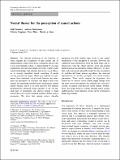| dc.contributor.author | Fleischer, Falk | |
| dc.contributor.author | Christensen, Andrea | |
| dc.contributor.author | Caggiano, Vittorio | |
| dc.contributor.author | Thier, Peter | |
| dc.contributor.author | Giese, Martin A. | |
| dc.date.accessioned | 2016-10-06T22:43:41Z | |
| dc.date.available | 2016-10-06T22:43:41Z | |
| dc.date.issued | 2012-04 | |
| dc.date.submitted | 2011-08 | |
| dc.identifier.issn | 0340-0727 | |
| dc.identifier.issn | 1430-2772 | |
| dc.identifier.uri | http://hdl.handle.net/1721.1/104782 | |
| dc.description.abstract | The efficient prediction of the behavior of others requires the recognition of their actions and an understanding of their action goals. In humans, this process is fast and extremely robust, as demonstrated by classical experiments showing that human observers reliably judge causal relationships and attribute interactive social behavior to strongly simplified stimuli consisting of simple moving geometrical shapes. While psychophysical experiments have identified critical visual features that determine the perception of causality and agency from such stimuli, the underlying detailed neural mechanisms remain largely unclear, and it is an open question why humans developed this advanced visual capability at all. We created pairs of naturalistic and abstract stimuli of hand actions that were exactly matched in terms of their motion parameters. We show that varying critical stimulus parameters for both stimulus types leads to very similar modulations of the perception of causality. However, the additional form information about the hand shape and its relationship with the object supports more fine-grained distinctions for the naturalistic stimuli. Moreover, we show that a physiologically plausible model for the recognition of goal-directed hand actions reproduces the observed dependencies of causality perception on critical stimulus parameters. These results support the hypothesis that selectivity for abstract action stimuli might emerge from the same neural mechanisms that underlie the visual processing of natural goal-directed action stimuli. Furthermore, the model proposes specific detailed neural circuits underlying this visual function, which can be evaluated in future experiments. | en_US |
| dc.description.sponsorship | Seventh Framework Programme (European Commission) (Tango Grant FP7-249858-TP3 and AMARSi Grant FP7-ICT- 248311) | en_US |
| dc.description.sponsorship | Deutsche Forschungsgemeinschaft (Grant GI 305/4-1) | en_US |
| dc.description.sponsorship | Hermann and Lilly Schilling Foundation for Medical Research | en_US |
| dc.publisher | Springer-Verlag | en_US |
| dc.relation.isversionof | http://dx.doi.org/10.1007/s00426-012-0437-9 | en_US |
| dc.rights | Article is made available in accordance with the publisher's policy and may be subject to US copyright law. Please refer to the publisher's site for terms of use. | en_US |
| dc.source | Springer-Verlag | en_US |
| dc.title | Neural theory for the perception of causal actions | en_US |
| dc.type | Article | en_US |
| dc.identifier.citation | Fleischer, Falk et al. “Neural Theory for the Perception of Causal Actions.” Psychological Research 76.4 (2012): 476–493. | en_US |
| dc.contributor.department | McGovern Institute for Brain Research at MIT | en_US |
| dc.contributor.mitauthor | Caggiano, Vittorio | |
| dc.relation.journal | Psychological Research | en_US |
| dc.eprint.version | Author's final manuscript | en_US |
| dc.type.uri | http://purl.org/eprint/type/JournalArticle | en_US |
| eprint.status | http://purl.org/eprint/status/PeerReviewed | en_US |
| dc.date.updated | 2016-08-18T15:27:04Z | |
| dc.language.rfc3066 | en | |
| dc.rights.holder | Springer-Verlag | |
| dspace.orderedauthors | Fleischer, Falk; Christensen, Andrea; Caggiano, Vittorio; Thier, Peter; Giese, Martin A. | en_US |
| dspace.embargo.terms | N | en |
| mit.license | PUBLISHER_POLICY | en_US |
| mit.metadata.status | Complete | |
